I’ve been drawing for so long, I forget what it feels like to learn how to draw. But once in a while, I learn something really basic for the first time. I wanted to write about it before I forget what it feels like.
The topic: spirals. I love ’em. I used ’em for clouds in Sita Sings the Blues:

And for ocean waves in my fake-Moghul-minature style:
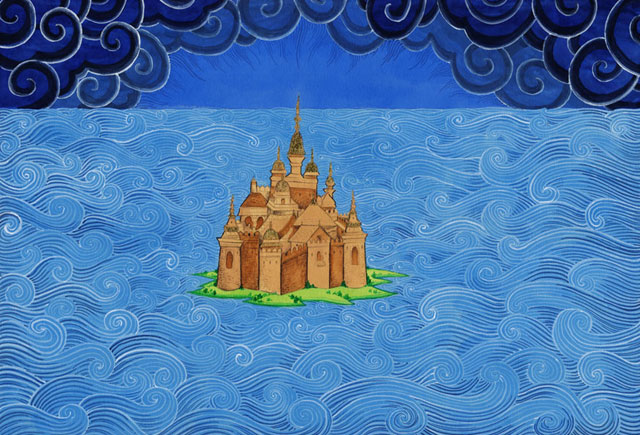
Now, I believe I can draw anything. That doesn’t mean I can just sit down and draw anything off the top of my head. What it really means is I can copy anything. Everything in my drawing memory banks originated from copying one thing or another at one time (notice how I used “originated” and “copying” in the same sentence). Everything I copy is stored somewhere in my head, and my muscles too – actually moving my hand around a shape forms my mind in a way that just looking doesn’t.
I’ve looked at a lot of pictures of Tibetan-style clouds. Some of these showed up in Indian art, in the Adventures of Hamzaa, the beautiful catalogue of which I owned until I left it behind with the bed bugs. Apparently Moghuls imported artists from all over Asia, which is why some Moghul miniatures are beautiful mish-mashes of Persian and Himalayan styles.
I saw the spirals in those cloud designs, so I drew clouds with spirals. They didn’t really look the same, which was fine – I wasn’t copying directly, merely being “influenced.” I made do with the spiral-drawing skills I had.
Fast-forward to today, and my new hobby: sewing. It turns out you can draw with an ordinary sewing machine! It’s called “free motion,” and I only learned it was possible last month. A few weeks ago I bought a machine and fabric and stuff, beginning another kind of spiral that’s taking over my life & apartment (more on that later). Drawing with a sewing machine is different from drawing conventionally in 2 significant ways:
- The “pen” stays still and you move the “paper” (fabric) around.
- You can’t lift the pen. It stays down the whole time.
#1 is simple in theory, but difficult in practice as I need to retrain my muscles. It’s like holding a pen for the first time, or drawing with my feet. I’m clumsy, for sure.
#2 seems simple – after all, isn’t drawing intricate designs with long meandering continuous lines what every stoned college kid does? Well, I haven’t been a college kid for 23 years, and I don’t get stoned (my few experiences with pot didn’t go very well). I never thought about how much I lift my pen. I usually draw with a lot of short strokes. I had to get in the stoned-doodling-college-kid mindset and keep my pen down.
I thought the cloud designs from SSTB would look nice quilted, so I used one in this, my first Trapunto experiment (more after the jump):
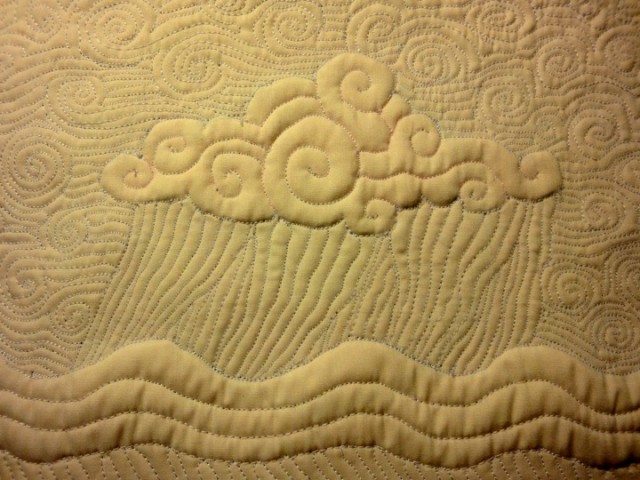
It looks OK, but I had to do a lot of starts and stops with the thread. The main cloud is not one continuous line (the background spirals are, more or less). I also had to plan it in advance; I couldn’t sew it freehand. I knew it should be possible to draw clouds freehand. Something was wrong.
I returned to studying Tibetan clouds. I visited the Rubin Museum and took pictures of some tapestries there.
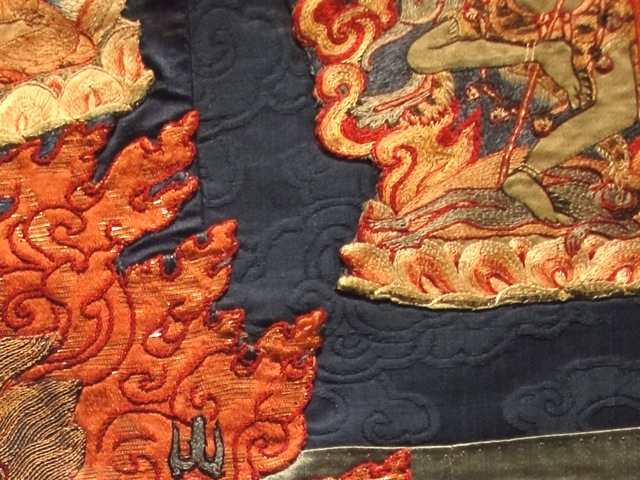
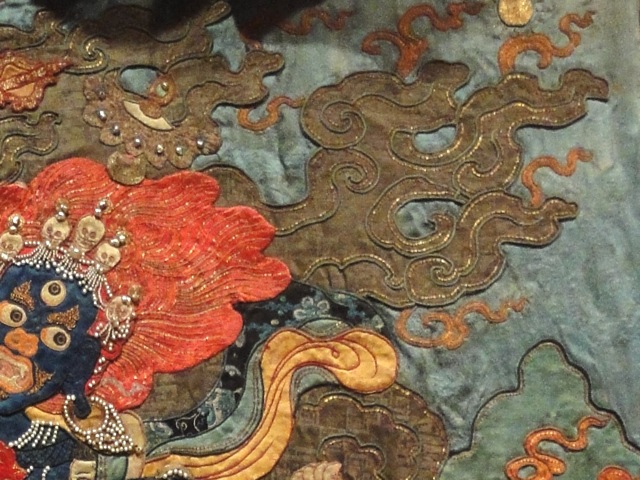
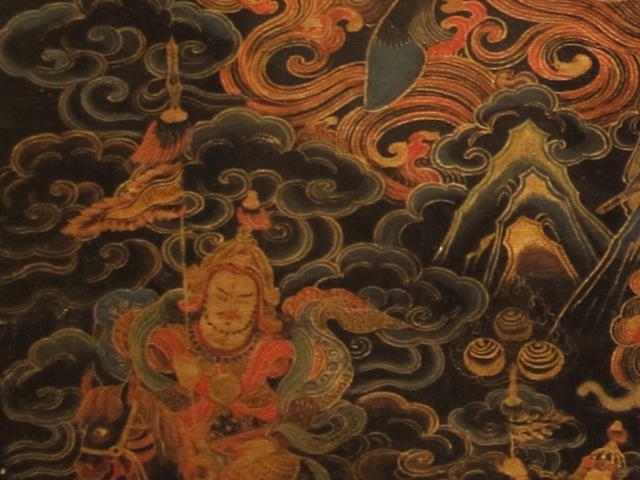
What was different about those clouds, from the kind I was doing? I could draw either kind if I lifted my pen, but keeping the pen down, I could only draw dense, maze-like spirals, with no open areas.
And then I saw it: when I reached the inner point of my spiral and “turned” to go back out, I was always turning in (toward the focus of the spiral):
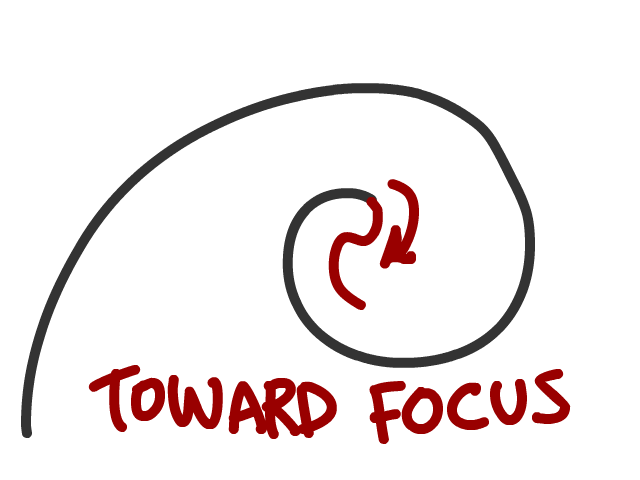
When I did that, the design became denser. That looks very nice, and is good for many things, but not Tibetan clouds:
Somehow I went my whole life doodling spirals this way. Last night, for the first time, I consciously turned the other way, away from the focus of the spiral. “Spiraling out” felt very strange at first. My hand, so practiced at “spiraling in,” didn’t want to do it. I had to force it the first few times.
And that’s the secret to drawing Tibetan-style clouds without lifting the pen:
Now, this should be filed under “D’uh,” But in my 40+ years of drawing, I never understood it before. Someone new to drawing spirals would probably “turn” either way; my habit of only “turning in” was so ingrained, I didn’t even realize there was another way out of the spiral. THIS IS BIG NEWS! Especially at 5 this morning when I couldn’t sleep. I just kept thinking about spirals. So I took out my handy bedside notebook and doodled like a stoned college kid:
Now I can easily draw Tibetan-style clouds and flames, freehand, without lifting the pen (or, in the future, the sewing machine needle). Another mystery unlocked! I can still learn!

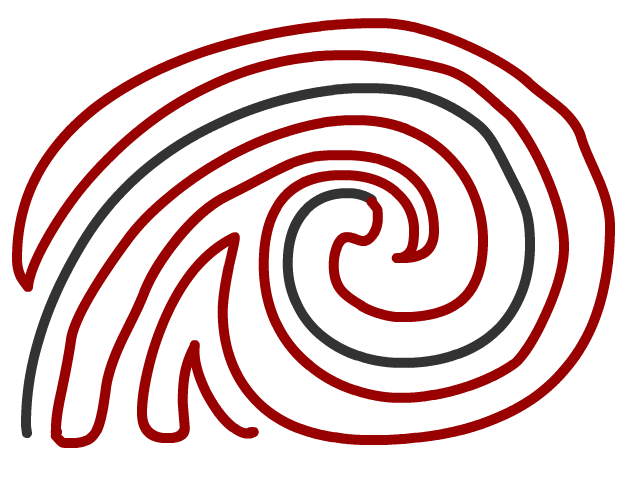
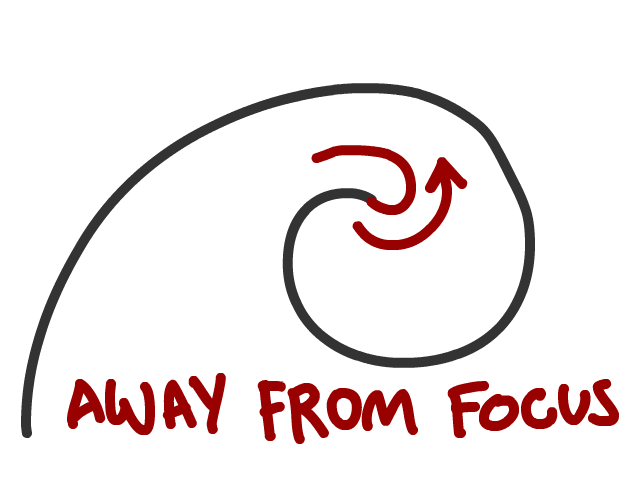
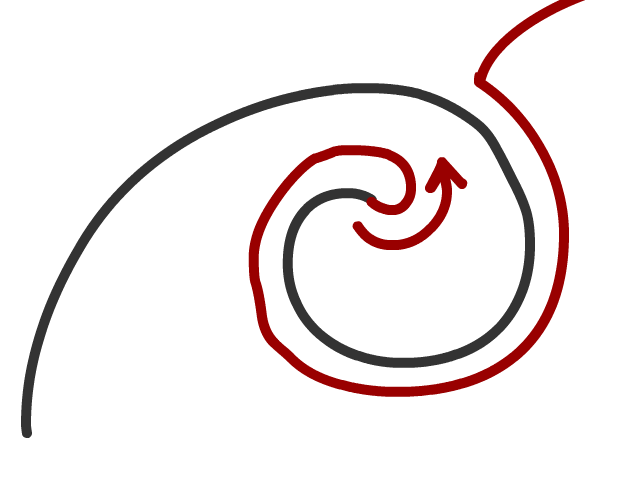
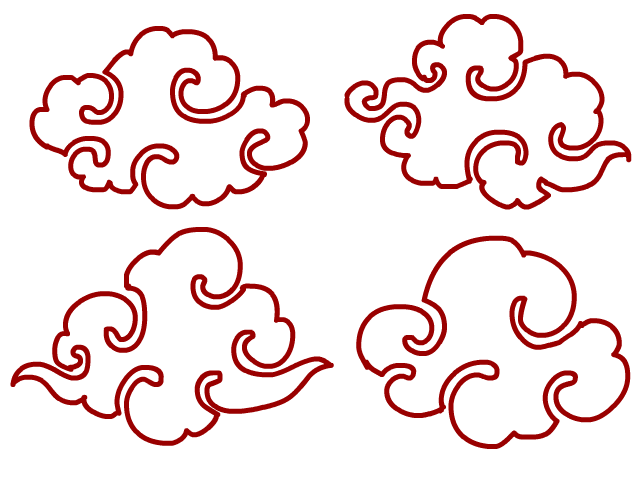
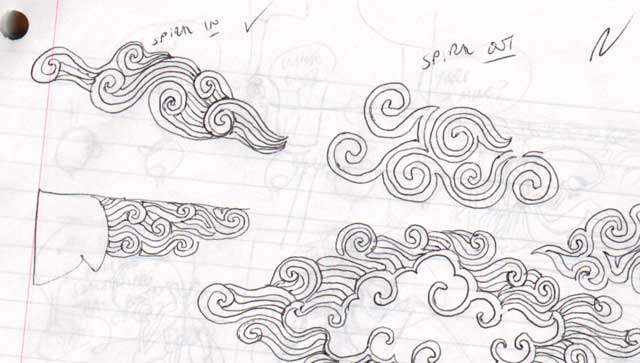
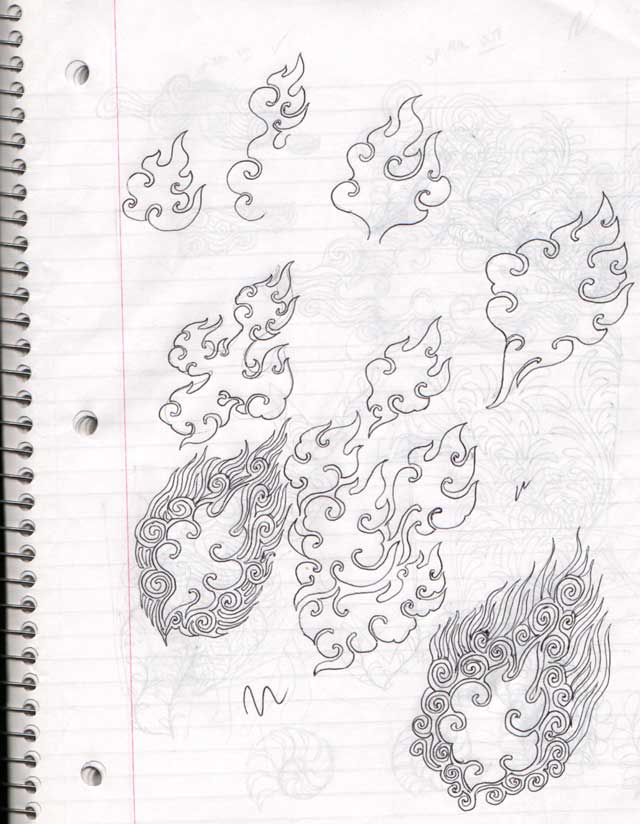
LOL! Wonderful.
That’s really nifty! I’m going to have to try that in my doodles.
Let me wish you Happy Ponggal. Part of this celebration is the making of
Kolam, elaborate rice powder designs with innies and outies. This one is animated.
I love it!
This reminds me of taking the SAME pottery open studio class several times in a row. The thing is, there were new students in it, and the teacher said different things to them. And it’s always good to do the beginning student exercises as an experienced student; you learn different things or you relearn things or you learn things from seeing others learn things.
I need to doodle more. 🙂
ps, what’s funny is … I find it hard to spiral TOWARDS the focus. My natural turn is out.
That makes me want to go out and doodle.
Nina, that is really cool. It reminds me a bit of some of the stuff by the brilliant an eclectic Douglas Hofstadter that used to fascinate me too–I think it was in his book Metamagical Themas — both his “ambigrams” and his “whirly art” — you should check it out, esp. the latter. see http://en.wikipedia.org/wiki/Douglas_Hofstadter : “Both inside and outside his professional work, Hofstadter is driven by a pursuit of beauty. He seeks beautiful mathematical patterns, beautiful explanations, beautiful typefaces, beautiful sonic patterns in poetry, and so forth. Hofstadter has said of himself, “I’m someone who has one foot in the world of humanities and arts, and the other foot in the world of science.” He has had several exhibitions of his artworks in various university art galleries. These shows have featured large collections of his gridfonts, his ambigrams (pieces of calligraphy created with two readings, either of which is usually obtained from the other by rotating or reflecting the ambigram, but sometimes simply by “oscillation”, like the Necker Cube or the rabbit/duck figure of Joseph Jastrow), and his “Whirly Art” (music-inspired visual patterns realized using shapes based on various alphabets from India). (The term “ambigram” was invented by Hofstadter in 1984 and has since been taken up by many ambigrammists all over the world.)[32]”
a bit more on Hofstadter’s Whirly Art — http://www.iuinfo.indiana.edu/HomePages/101698/text/hofstadter.htm — also if you do a google images search on Douglas Hofstadter Whirly Art I think a few examples show up
Thanks! I gotta say, an image search on Hofstadter Whirly Art turns up almost nothing (the little there is is cool though). Is Hofstader one of those keep-my-pooperty-off-teh-interwebs people? Or is his visual art just not well-known enough?
Spirals are my favorite thing about Celtic art!
You are simply brilliant.
This is really really awesome. I’m working a redesign of my portfolio site and I plan on do some continuous line typography. That’s how I stumbled upon this page. Your work is inspiring. The sewing is just amazing!
Muito bom o teu método! Este tipo de desenho é, na minha opinião, o mais belo e simples que um artista pode fazer! Obrigado pela publicação de algo assim, de uma descoberta! ^^
So I just googled “how to draw Tibetan Clouds” because I wanted to use them in a free motion quilting design. I just started learning to do this, and it seemed like these clouds would work, . So of course your page was the first hit, and is exactly what I was looking for.
Thanks for getting there first and paving the way!
Thank you so much, awesome tutorial on this (I could have stared at that picture for hours and not seen that).
Wow! just what I was looking for. I’m working on a skyline scene and have quilted buildings, trees & sky. When it came to clouds, I was having a hard time envisioning puffy clouds, not too dense and what the quilting should look like. You nailed it. I was almost going to leave them blank, but some were a bit large for that. Now I can complete the skyline. Thanks a bunch
Great ideas. I’m interested in the same sort of thing – especially filling space with non-repeating, Tibetan-style swirls (clouds, flames, water, plants, flowers – the lot). I’ve been doing quite a lot with Celtic knots – both on the traditional grid, but also experimenting with hexagonal grids (have a look at celtic_zoomorphs on instagram – all the work generated the fonts (free) at https://fontlibrary.org/en/font/knots
I still have a way to go before I am really satisfied with the swirls though. This was a good call! Thanks, Nina.
Nina, uncountable instants of appreciation surround you.
My life is so much richer because you exist!